As dozens of thirsty and exhausted asylum seekers wandered the ochre-red dirt tracks criss-crossing Dampier Peninsula’s remote bushland in February, the crew of the $50 million patrol boat meant to stop them from reaching Australia’s mainland were dealing with the fallout of their own crisis.
A fire and communication systems failure had crippled the Australian Border Force’s boat, Cape York, as it patrolled off the scrubby Kimberley coastline where the 39 men were now lost.
The blaze was caused by a leaking hose that had sprayed oil into the Cape York’s engine room just as an Indonesian fishing boat-turned-people-smuggling vessel had tracked towards a strip of sand about 150 kilometres from Broome.
An Australian Border Force Cape-class boat used for patrol operations against illegal fishing and people smuggling.Credit: 60 Minutes
As flames licked the floor and engine casing, threatening to engulf the entire engine room, Border Force officers raced to extinguish the fire. The Cape York limped back to Darwin on a single engine, leaving its patch of ocean unguarded.
About 48 hours later, news broke of the arrival of the 39 foreigners. But the Cape York’s problems stayed secret.
“Had there not been a fire, the asylum seekers would have been located,” a former Border Force Cape-class crew member told this masthead, speaking anonymously because it is an offence under Operation Sovereign Borders secrecy laws to speak to the media.
The Cape York’s problems were uncovered in an investigation by this masthead and 60 Minutes alongside claims from multiple Border Force insiders of much bigger problems dogging the entire Cape-class fleet involving multiple known – but unresolved – defects.
They claim the problems badly undermine the eight-strong fleet’s mission to confront illegal fishing and people-smuggling in Australian waters.
Along with major fire risks, communications and vital oil leak alarm systems regularly fail to work properly.
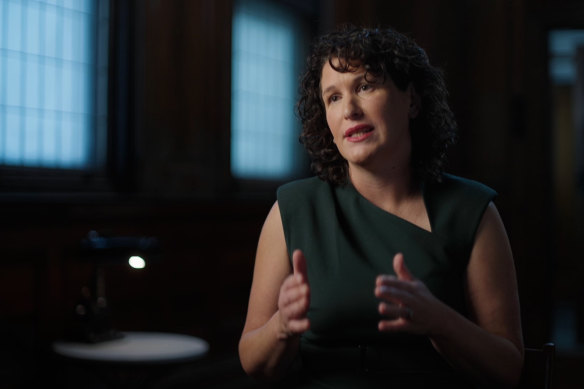
Community and Public Sector Union national secretary Melissa Donnelly says her members’ lives are being put at risk.Credit: 60 Minutes
Border Force crews have been forced to go to Bunnings to buy fans to cool equipment at sea. Border Force staff fed up with mould, noxious gas leaks and communications failures, which leave them unable to contact their family during weeks-long operations, are quitting or considering legal action.
The flaws limit Border Force’s ability to confront a spike in vessels illegally fishing and smuggling people.
“There’s not been one boat that does not have problems, and as a result, they’re often not mission-capable,” the former Border Force official says.
Loading
Five serving and former Border Force insiders, along with the union that represents them, also claim the serious defects compromise safety for Cape-class crews, fuelling an officer attrition problem.
“Vessels are going to sea with defects, and that’s putting our members’ lives and their jobs at risk,” says Community and Public Sector Union secretary Melissa Donnelly.
The beneficiaries of these problems are twofold: private contractors that are paid millions of dollars to fix broken boats, and those intent on testing Australia’s border security. Among the latter group are people-smugglers and illegal fishermen like Ali Sarwano (not his real name).
Four months have passed since his mission to Australia, but Ali recalls the trip like it was yesterday. His white, wooden boat was cruising on a roiling Timor Sea, still a day’s travel from the Dampier Peninsula, when it ploughed into a submerged log the size of an oil drum.
The blow seized the engine, busted the propeller and almost flipped the boat with its passenger load of three people-smugglers and 39 south Asian migrants. Spared drowning, they were now drifting, panicked, at sea.
In the onboard lingua franca of hand gestures and broken English, the Indonesian skipper called for calm, Ali told this masthead and 60 Minutes. That they had made it even this far was a confluence of mistakes and mastery.
“We knew their schedule,” says Ali of Australia’s surveillance patrols, a claim repeated elsewhere by Indonesia’s illicit border men. But without power, they would need good fortune as well.
“When it [the engine] broke, I wasn’t thinking about the authorities. Not then.”
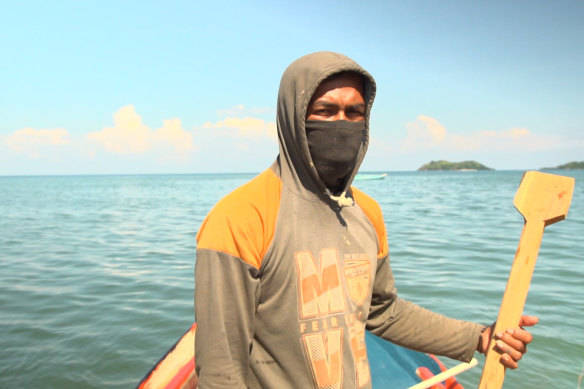
Ali Sarwano is a people-smuggler and fisherman.Credit: 60 Minutes
As the amateur mechanic among the people-smugglers, it was Ali’s job to restore power and replace the propeller.
They had lost half an hour when the boat grunted to life, albeit with reduced speed. Passengers and crew celebrated. They would survive.
The asylum seekers – from Bangladesh, Pakistan and India – had been at sea for four days when through the dark, they caught the shades of the wild north-Kimberley coast.
“Some were jumping up and down,” Ali says. In jubilation and anxiety, they leapt into the shallow, warm water before the boat even made it to shore.
Hours later, they were discovered, banged-up and dehydrated, by locals from the remote Aboriginal community of Beagle Bay, who alerted Border Force. The men were promptly detained and were soon on a plane heading to Nauru.
Their successful landing triggered controversy in Canberra as Opposition Leader Peter Dutton accused the Albanese government of failing to manage Operation Sovereign Borders.
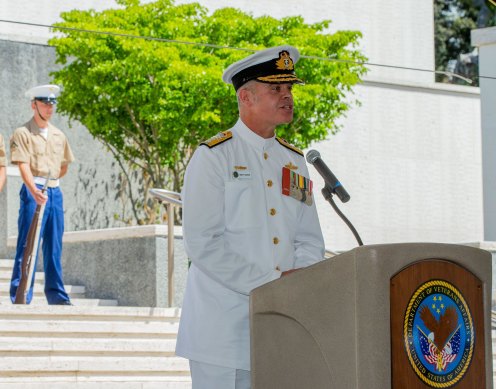
Rear Admiral Brett Sonter.Credit: Alamy
Operation commander Rear Admiral Brett Sonter insisted the “mission of Operation Sovereign Borders remains the same today as it was when it was established in 2013”.
“Any alternate narrative will be exploited by criminal people-smugglers to deceive potential irregular immigrants and convince them to risk their lives and travel to Australia by boat,” he warned.
Sonter said nothing of the Cape York’s fire and communications problems and did not acknowledge that Ali’s success in reaching the mainland – rather than any Opposition rhetoric – could propel the smugglers’ narrative.
Loading
There was also no mention of the fact that over the past three years, increasing numbers of Indonesian fishermen have mastered the art of creeping further and further into Australian waters to plunder sea cucumbers and fish.
Interviews with Indonesian fishermen and smugglers, along with Border Force insiders and the head of Indonesia’s maritime security agency, all suggest that the success of fishing raids in Australian waters meant it was only a matter of time until they turned to a more valuable commodity: people.
“They’re really very … clever. They travel at night when it’s very dark. They also paint the boats black. Given the preparations they make, they’re convinced that they’re going to get through,” says Pung Nugroho Saksono, the director general of Indonesia’s maritime agency.

Pung Saksono, the director general of Indonesia’s maritime agency, says people-smugglers are ramping up their activity.Credit: 60 Minutes
Ali is a case in point. Facing mounting debts, the poverty-stricken, diminutive father of three from the South-East Sulawesi province was lured by the promise of money that he could never hope to make on weekly fishing trips, where he might earn the equivalent of $14 a day.
“I was desperate, so when [captain] Dedi offered me the job of smuggling people, I said ‘yes’.”
Dedi had made the trip to Australia before – albeit usually to fish illegally, rather than transport people. He assured Ali they could easily beat Australia’s border controls. Knowing Ali’s knack for motors, Dedi roped him in for just $3000.
“The captain chose a route he had already taken before. He’d taken the patrols into consideration and knew how to avoid the Australian Border Force,” says Ali.
In early February, on the orders of his handlers, he left the Bombana Regency for Bali’s Denpasar, waiting at a hotel for about four days until moving again to a surfing retreat up the coast, about 70 kilometres from Kuta.
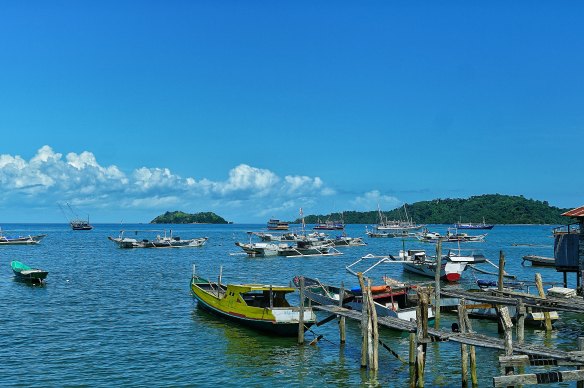
Sarwano’s village in South-East Sulawesi province.Credit: Amilia Rosa
Medewi Beach is hugged by rice fields, postcard-perfect palm trees and a world-class surf break, but Ali, Dedi and a third fisherman-turned-smuggler paid no attention to these things.
For four days, after they checked in on February 7, these three peculiar guests shared the same room, and only left it to eat at the in-house restaurant, according to resort staff.
A mysterious fourth man of south Asian appearance, who was not a guest, appeared with cash when it was time to pay.
On February 11, the smugglers left the hotel for the first and only time, heading for the designated slice of deserted beach. It was here that the three crew and 39 passengers boarded the waiting boat. In the muggy night, they glided into the sea on the power of a modified car engine, desperation and the promise of Australia.
At 26, Murray Barker is the youngest skipper in a five-vessel fishing fleet based in Darwin. He has sympathy for men like Ali.
Barker reckons that if he was born in an impoverished Indonesian fishing village, he, too, would venture to Australian waters searching for fish.
Barker, who began working for his father’s Darwin fishing operation as a teen, has less sympathy for Border Force.
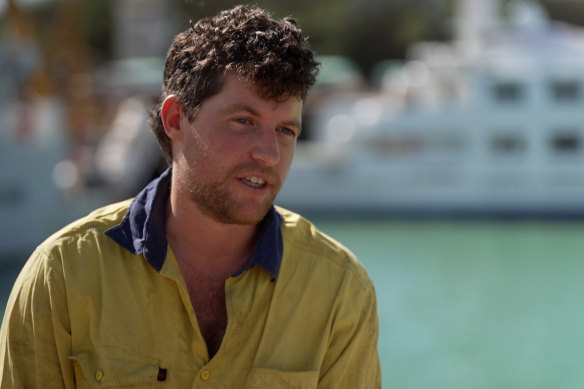
Darwin fishing boat skipper Murray Barker says there are so many illegal fishing operations to Australia’s north they are now part of the scenery.Credit: 60 Minutes
Scruffy, tanned and handsome, Barker blames it for what he claims is a major and consistent increase in illegal Indonesian fishing off the Kimberley coastline.
Before the COVID-19 pandemic, Barker might have encountered the occasional Indonesian fishing vessel unlawfully plundering local waters; now, he sights illegal fishing operations more than a dozen times in a two-week trip.
“We’re seeing a lot more motorised vessels, bigger boats, more boats, coming deeper into our fishery. They’re not so scared of the line [maritime border] any more. They come right down and just go for it really,” he says.
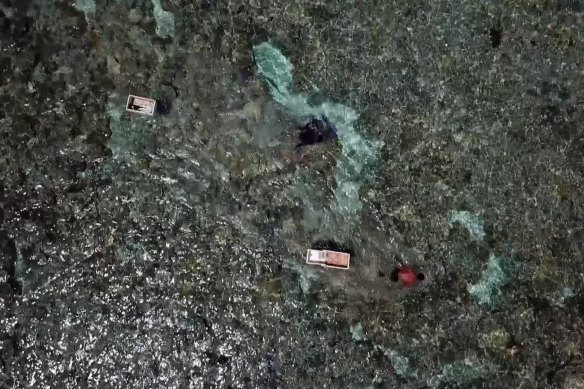
An Indonesian fisherman looking for sea cucumbers in Australian water.
There are multiple accounts of Indonesian fishermen setting up hidden camps on Australia’s mainland, fishing for days before rendezvousing with a so-called mothership waiting on the Indonesian side of the maritime border.
Barker’s first-hand experience of the surge in illegal Indonesian fishing is not only backed by other Australian fishermen who spoke to this masthead, but by the Australian Fisheries Management Authority, whose chief last November publicly acknowledged a “very high number of those [unlawful fishing] incursions” after the COVID-19 pandemic.
Where the Australian fishers and authorities diverge is whether the official response to the problem has been adequate.
The Australian Fisheries Management Authority and Border Force regularly publish press releases highlighting the large numbers of Indonesian boats being intercepted. Border Force says that in the past year, it has interdicted 261 illegal fishers.
Barker isn’t seeing the impact. He sees many Indonesian fishermen operating with impunity.
“There are so many of ’em and there are so many more of them. And they’re coming back more regularly. So, you know, there’s been a huge increase. And it’s not going down, it’s going up.”
He says authorities often fail to respond to complaints and his crews have even taken matters into their own hands, forcing Indonesian boats back over the sea border.
“It’s not battleships. But if we steam at them, they’ll pick up and go back over the line and sort of ‘message received’.”
The response of Australian authorities is now firmly back on the table, but not over concerns about illegal fishing.
Loading
In the past six months, three fishing boats bearing “irregular migrants” have reached Australian territory, including the boat bearing Ali, and three more vessels have come close to reaching land. Australian agencies are worried.
Indonesian fisheries agency chief Saksono says Australian officials recently implored their Indonesian counterparts to “crack down” on the smugglers operating in Indonesia.
“The Indonesian authorities will be much more vigilant after recent incidents,” he says. “We are in intensive communication with our partners in Australia, so we are sure that we can tackle this problem.”
The rhetoric matches Border Force’s talking points, but those who have served inside the Australian agency, including Cape-class crew members, say the reality doesn’t match their experience.
‘They were thrown into the piss [the water] and saw this propeller go above their faces.’
Border Force insider
Five serving and former Border Force officials, including some who have served on the Cape-class vessels, detailed a litany of defects affecting safety and effectiveness.
Internet and encrypted communications systems on the boats often fail, forcing crew members to chip in to buy their own platforms.
Design flaws mean Border Force crews cannot enter some of the Kimberley waterways favoured by Indonesian fishermen. The flaws also mean that during certain operations, the ship’s tenders take on excess water and are at great risk of rollover.
Union chief Melissa Donnelly describes Border Force officers tossed into the sea from a tender during one operation in which they had to be rescued.
A Border Force source describes the incident in more terrifying terms: “They were thrown into the piss [the water] and saw this propeller go above their faces.”
Key specifications: Cape-class patrol boats
- 58.1 metres long
- 3.1 metre draught
- 22 crew
- 26 knots top speed
- 4000-nautical mile range at 12 knots
- Two deck-mounted 0.50 calibre general-purpose machine guns
At least one tender has sunk in crocodile-infested waters after its hull was split on a submerged rock.
Three sources described crew members making emergency runs to a Bunnings hardware store, buying fans to keep equipment – including switchboards in the mid-plant room – and living quarters from overheating.
Critical generators are faulty. Crew have long-standing complaints about exposure to electrocution hazards, mould and noxious gases that would not be permitted in other workplaces.
The consistent comment from four Cape-class crew members, as well as senior Border Force officials in Canberra, is that the eight-vessel fleet is simply “not fit for purpose”.
Boats are often stuck in maintenance or forced to head out to sea without the ability to actually patrol and intercept effectively.
One insider describes “non-mission capable boats just stooging around” on patrol.
“Someone will have to die until they change them,” says the insider.
The number of recent boat arrivals is a fraction of the smuggling heyday of 2013, when a surge of 300 boats brought more than 20,000 people and the $330 million Cape-class fleet was still under construction.
A decade later, Border Force figures show that the boats still aren’t hitting their patrol numbers. The Cape-class fleet has logged 12.2 per cent fewer patrol days in 2022-23 than two years earlier; aerial patrols are also down.
In a statement, Border Force conceded that “patrol days for ABF vessels has reduced due to the requirement for Cape-class vessels to undergo mandatory depot-level maintenance” and that “mitigation measures” included relying on the navy “and/or leased vessels”.
When asked about purchases at Bunnings, it also confirmed that fans were bought to cool equipment and that outdated communications systems were “nearing end of life and are progressively being replaced by contemporary communication technologies”.
Loading
The Border Force sources say problems are not getting fixed quickly enough and staff are quitting as a result, with land-based marine engineers in critically short supply.
A recent Human Rights Commission report into the sexual harassment of female crew members also hit morale, as have efforts to outsource a temporary Cape-class relief crew.
While welcoming Border Force’s recent modest budget boost, union secretary Donnelly says it was far too small to fix the Cape-class problems driving her members to leave or fear showing up to work.
“Our members are telling us of workplace health and safety incidents every day,” she says. “Every time a mariner works on that boat, their family is worried about their workplace health and safety, and if they’re going to get home safe. It is taking an incredible toll.”
The Border Force insiders say that while dozens of illegal fishing vessels have been intercepted, plenty go undetected.
“There are heaps we couldn’t get,” says one.
The Cape York’s fire and communications failure was, according to insiders, the culmination of highly concerning and avoidable problems.
A faulty hose connected to the operation of the small cranes that lower the Cape York’s tenders into the water had earlier exploded, coating the engine room in highly flammable oil that also posed a major health risk.
The problem with the leaking hose was known, according to sources, for more than a year, and it was “not a matter if it blows, just when it blows”.

Crew fighting the fire on the Cape York.
That risk was exacerbated by problems with oil-mist detectors that are meant to alert a crew to a leak – but were unreliable.
“The only reason the crew knew there was a fire was they saw it on CCTV. They legged it down and put it out. If it happened the day before, when some of the crew was out, the whole boat would have gone up,” says a former Cape-class crew member.
“If the fire had happened during a night op, it could have been disastrous … it could have led to an abandoned ship or cost lives. The York could have had a total engine room fire. They would’ve lost the entire ship … all from a known fault.”
In response to questions from this masthead, Border Force confirmed the Cape York’s problems, stating that “the ABF Cape York had developed communication difficulties and at the time of the fire was commencing its return to Darwin for repairs to the communication equipment”.
“ABF Cape York returned to Darwin on a single engine which it is capable of doing safely if required” and “the oil leak and fire were both reported to Comcare, and ABF conducted its own workplace health and safety investigation”.
The Cape-class vessels have a long history of expensive problems that led to the previous Coalition government facing questions about the fleet’s safety and capability, as well as allegations that Border Force had allowed the ship builder and maintenance supplier, Austal, to deliver substandard vessels.
Loading
In November, the National Anti-Corruption Commission published a summary of an investigation into Border Force’s interactions with Austal that cleared the agency of corruption but identified “a number of corruption vulnerabilities”, including a failure to keep adequate records.
Home Affairs was directed to “review its high-risk, high-value contract management process to ensure effective controls have been implemented”.
In a statement, Border Force said these changes were made and, while conceding problems in its fleet, insisted they were continuously rectified and Operation Sovereign Borders was as robust as ever.
“Our government is committed to giving them the support and resources that they need – that is why we have delivered record funding to border protection,” Home Affairs Minister Clare O’Neil said in a statement.
The agency denied claims that the Cape York’s problems had contributed to the arrival of the 39 asylum seekers, but confirmed another previously hidden fact — that the people-smugglers were, in fact, caught on their way back to Indonesia.
This, too, isn’t quite what it seems. Ali insists he would have reached Indonesian waters if not for another failure on the smugglers’ vessel.
“It took me three hours to fix it. That was when the Australians caught us. If we didn’t have machine problems, we would’ve gotten away.”
A circling drone was the first sign the game was up. By nightfall, the Australians had crept up on a ship. “We didn’t see them coming,” Ali says. The boat was burned at sea and Ali and his two fellow smugglers were arrested and taken to Darwin.
Loading
Rather than face Australian people-smuggling laws, the trio was deported to Indonesia after about two weeks.
“The next thing I knew, we were flown to Jakarta, to the national police headquarters,” recalls Ali.
“We were questioned there for a few days. It was March by then. I co-operated fully. Then they sent me home.”
In response to questions about why Australian authorities didn’t charge Ali in Australia but instead sent him back to a justice system dogged by corruption and resourcing problems, Border Force said: “The three Indonesian crew were … returned to Indonesia for appropriate criminal justice action under Indonesian law.”
Ali is not his real name. This masthead has also agreed not to name his small village in South-East Sulawesi province. Indonesian authorities hope he can help unpick a global people-smuggling network, which may make him a target.
The arrests did not deter the people-smuggling upper hierarchy. Once home with his wife and kids, Ali took another call, not from small-time Dedi, but a “big boss” who knew of the February mission and wondered if the engine-man might have another go, this time ferrying migrants from China using a faster boat.
Ali knocked it back. “My wife was in a panicked state, worrying about what would happen to me.”
But the boss may have found someone else: on April 5, a group of 10 Chinese nationals wandered into Truscott Airbase.
Indonesian sources told this masthead that the under-resourced West Timor police on Rote Island had sought but failed to earlier intercept the boat.
According to fisheries chief Saksono, “the [smuggling] networks are quite big, but the Indonesian authorities are onto it”.
Among Border Force crews, there is anxiety about confronting the illegal fishing craft – and perhaps people-smugglers – planning to exploit the coming reprieve in weather.
A Cape-class crew member warns: “The next few months bring nice weather patterns. Indonesians are great sea-going people. They navigate by the stars. There will be a surge.”
Watch 60 Minutes here.

